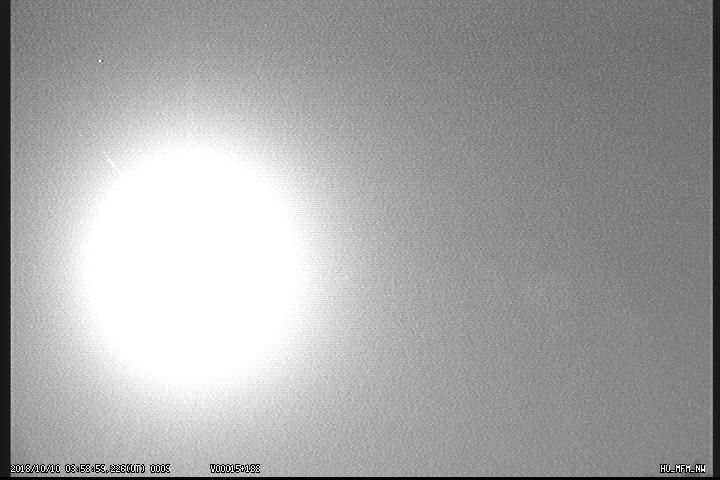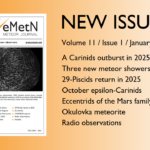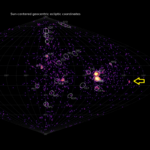On 10 October, 2018 at 3:58:59 UT a Full Moon bright bolide exploded high above Hungary. One of my meteor cameras successfully caught the phenomenon from begin to end. Because this was my brightest capture in the last five years, I decided to collect data and calculate its trajectory and orbit as precise as I can. The preliminary calculation shows that this was likely an Orionid fireball and that it ablated totally in the atmosphere.
1 Introduction
On that morning – as always – I checked my cameras uploaded pictures on their homepage and surprisingly realized an oversaturated image among the others. I immediately downloaded the data which was automatically analyzed by the system (SonotaCo, 2009, http://videometeor.co.nf – The only Hungarian video meteor system based on UFOTools).

Figure 1 – The bolide’s snapshot on the north-west camera from Budapest, Hungary.
2 Detailed story
I collected every reachable picture about this event. Unfortunately, the Hungarian Video meteor Network’s online reachable cameras had been stopped operating before the bolide because the sunrise’s time was very close to the falling. This early hour also caused that we haven’t any visual observation. So, I turned to the online meteorological cameras and luckily, we have hundreds spread across the country and there were a dozen among them which had taken pictures of it. But these are just still images and these have to be manually calibrated all of them one by one with UFOAnalyzer. That’s why I chose only four of them – the easiest ones all around the meteor trajectory – in addition to my dedicated meteor camera’s data.
I tried to widen the search and I found many pictures about the drifted trail on Austrian meteorological pages. The Czech meteorological cameras also managed to catch the meteor’s trail immediately after the fall. I put a post on the EDMOND facebook page to find more observations and Jiri Srba contacted me and sent their (Observatory Valasske Mezirici, Czech Republic, https://www.astrovm.cz/cz/) data. It also contains a spectral recording but it is probably affected by the trees (large patches in place of dots/lines on both visual ends) and contains no zero order, so it would be hard to analyze properly.

Figure 2 – The bolide’s snapshot from Valasske Mezirici, Czech Republic.
3 Trajectory
I have six observations all around the meteor trajectory, four of them are calibrated manually and two dedicated meteor cameras.
Table 1 – Overview of the 6 observations used in this analyzes.
| Site Name | Resolution (pixel) | Field of view (degree) | Max. Error (degree) |
| (HU) Bp. Kelenföld | 720×480 | 57.3 | 0.07 |
| (HU) Hajdúszoboszló | 1920×1440 | 69.6 | 0.15 |
| (HU) Bp. Megyer | 2688×1520 | 81 | 0.12 |
| (HU) Zselic | 640×480 | Allsky | 0.3 |
| (HU) Barlahida | 1920×1080 | 78.6 | 0.12 |
| (CZ) Valasske Mezirici | 720×576 | 74.6 | 0.06 |
I also had to manually measure begin- and endpoints in UFOAnalyzer, because the software calculation depends on detection’s thresholds omitting frames especially from the beginning of a fall. I used UFOOrbit’s (SonotaCo, 2009) import function to deal with the measured points.

Figure 3 – UFOOrbit calculated trajectory based on six calibrated observations.
The meteor started its luminous path very early at 137 km with an angle of 60 degree to the Earth surface. At 90 km high in the atmosphere it began to ablate heavily and after 10 km along the trajectory it reached its peak brightness in a great explosion at 81 km high. The thickest part of the plasma cloud was more than 2 km wide. During slightly more than one second the meteor went from Borzavár to Nagyigmánd (80km distance) with an enormous speed of 66.7 km/s (Figure 3). A tiny piece of the original mass could survive the detonation and continued its flight for about another 10 km where it died out at 72.2 km high.

Figure 4 – The remaining piece after the main explosion, the camera was quick enough to adjust its aperture frame by frame, so the brightness was affected by that.
4 Orbit and origin
I don’t have any velocity information from the meteorological camera’s detections because they are just still images. The other two are dedicated meteor cameras with exact timing frame by frame. The orbital elements are calculated from these two observations taking into consideration the velocity changes. Because of that I used only the first third part of the trajectory. I draw the attention to the fact that without error range calculations the resulting orbit is just a rough estimate.
Table 2 – The orbital elements of the fireball compared to the Orionids and their parent comet P/Halley.
| Orbital elements | Fireball | Orionids | Comet Halley |
| a (AU) | 11.8 | 15.1 | 18 |
| q (AU) | 0.517 | 0.571 | 0.587 |
| e | 0.956 | 0.962 | 0.967 |
| ω (°) | 89.2 | 82.5 | 110.7 |
| Ω (°)) | 16.5 | 28 | 56.8 |
| i (°) | 172 | 163.9 | 162.3 |
All the orbital elements (Cook, 1973) are near the Orionids ephemerides and they are in between the error boundaries of the stream, except the inclination which is 10 degree away. It is five times more than the greatest acceptable distance. The fireball’s radiant was very close (RA. 81° and dec.+9.5°) to the Orionids radiant (RA.80.97° and dec.14.37° – daily motion corrected values) but far enough to be rather an individual debris then part of the main stream (Table 2, Figure 5).

Figure 5 – UFOOrbit (SonotaCo, 2009) calculated orbits with subtle differences – rarely accurate – between the observations.
5 Light and mass
Programs like UFOCapture (SonotaCo, 2009) aren’t the finest tools to measure precise light curves for meteors. In this case before the brightest flash – at around –5 magnitude – the software couldn’t fallow the meteor’s trajectory and calculate its brightness because the highly saturated images. I have to estimate its peak brightness with the aid of an old picture about the Full Moon. It was definitely in the same category from Budapest (Figure 6).

Figure 6 – Full Moon compared to the fireball.
I calculated the photometric mass from the basic parameters of the event, absolute magnitude, velocity and zenith angle. (Jones et al., 1989) The original mass was 7.2 kg (±1.4 kg) which corresponds to a 16 cm diameter spherical body assuming a density of ordinary chondrites. Only a 3 mm diameter (0.05g) small grain survived the great explosion and continued its flight for the last 10 km. This could be the toughest part of the original body maybe just one chondrule.
6 Unusual observation
During the frame by frame measurement of the beginning of the meteor something odd caught my attention. A little fuzzy dot appeared and disappeared (two frames long event) on the same trajectory while the main event got brighter and brighter (Figure 7). I tried to find it on the other video (from the Czech Republic) but without any luck, it was too faint from that far. Likely it was part of the original body and was separated early by the Earth gravitational field. Assuming the same trajectory, this pebble had 1.2 mm diameter and 0.003 g with its absolute magnitude of 2. The distance between the two bodies was 3 km. This observation would be impossible without video meteor networks which are capable at such speed.

Figure 7 – It is difficult to see this tiny object on still images but it is clearly visible stepping the frames.
References
SonotaCo (2009). “A meteor shower catalog based on video observations in 2007-2008”. WGN, Journal of the International Meteor Organization, 37, 55–62.
Cook A. F. (1973). “A working list of Meteor Streams”. In Curtis L. Hemenway, Peter M. Millman, and Allan F. Cook, editors, Evolutionary and physical properties of Meteoroids, Proceedings of IAU Colloq. 13, held in Albany, NY, 14-17 June 1971. NASA SP-319, Washington DC, 183–191.
Jones J., McIntosh B. A. and Hawkes R. L. (1989). “The age of the Orionid meteoroid stream”. Monthly Notices of the Royal Astronomical Society, 238, 179–191.





